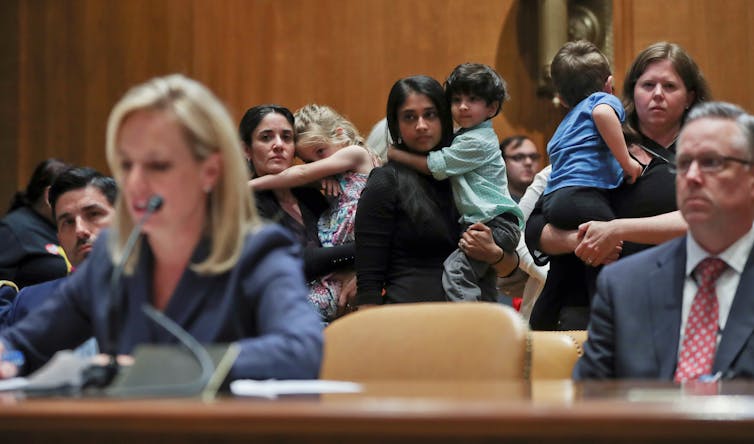
The Trump administration is deliberately taking immigrant children away from their parents. This practice, which has already elicited objections from the United Nations, is being applied when foreign families are either caught crossing the border without documents or if they turn themselves in to seek refugee status.
Many of these children are under the age of 4 and some are infants, according to media reports and rights advocates.
Just like when immigration authorities and border agents encounter children who arrive on their own, kids from families the government splits up initially spend a few days in federally run processing centers that are by all accounts ill-suited for child care. Then they are relocated to approximately 100 federally funded shelters run largely by nonprofit organizations or put into foster care homes supervised by many of the same organizations.
These nonprofits provide unaccompanied children with health care and education. They also help find “sponsors” – usually extended family members – with whom children can be placed while waiting for their cases to be heard. When no sponsors are found, the kids stay in shelters or foster care until their asylum cases are heard, or they are deported.
When I researched this largely hidden aspect of immigration policy, I found little evidence that this patchwork system can absorb what promises to be an influx of thousands more children, many requiring round-the-clock attention. And I have no doubt that forcibly separating kids from their families is completely impractical and bound to make a bad situation worse.
New policy vs. old rules
The Trump administration reportedly began to pilot this practice in 2017. John Kelly openly discussed family separation to deter new arrivals in March of that year when he was leading the Department of Homeland Security. It became official when the government adopted a new zero-tolerance immigration policy in April 2017, announced a month later, that calls for prosecuting everyone who enters the U.S. without permission.
Regardless of what President Donald Trump has insisted, this is a new interpretation of federal immigration law. Family separations like these did occur during the Bush and Obama administrations but were rare.
Trump’s policy change is turning children into unaccompanied minors. Thousands of children, who previously would have stayed briefly with their relatives in family detention centers before appearing in court or being deported, now must depend on the government for room and board.
Some 11,000 immigrant children were in federal custody as of late May, a 20 percent increase over the prior month, The Washington Post reported, citing the Department of Health and Human Services.
Known as HHS, the agency estimates that the Trump administration has given approximately 50 organizations located in more than a dozen states across the nation US$1.6 billion over the past 20 months to house, feed, educate and care for these children, according to the data I found on the agency’s website.
Many of these organizations are faith-based, and often they are rooted in their local communities. Others may be juvenile detention facilities or homeless shelters. Simply put, they must have at least some beds to spare but they do not necessarily have to employ culturally competent staff or run programs designed specifically to accommodate immigrant children.
But to house children under the age of 18, providers must – at least ideally – prove that they can support them in a humane and homelike environment, provide case workers and if necessary, locate more permanent and appropriate arrangements like foster care, according to the Office of Refugee Resettlement. These programs are run primarily by social service organizations.
While local, state and federal laws and regulations related to child care change over time, there are some common denominators. At a minimum, these contractors must be state-licensed and employ qualified professionals capable of helping these kids reconnect with their relatives. That demands not just legal expertise but the ability to communicate with them in their own languages.
Children housed in shelters don’t attend local schools. They are taught on-site instead, which means that the facilities need to provide age-appropriate teaching staff. That drives up costs further.

Little public scrutiny
I had previously found that the nonprofits the government pays to provide these services are often granted significant leeway in terms of how they fulfill their contracts. However, it is hard for Congress and the public to find out what goes on behind closed doors.
Indeed, one of these nonprofit-run shelters in Brownsville, Texas, recently refused to let Sen. Jeff Merkley visit. Later, the Health and Human Services Office of Refugee Resettlement, which manages the nonprofit’s government contract, said this was how it responds to all “unannounced” visits – even though the Oregon Democrat had requested a tour and had scheduled two similar tours nearby.
Like the senator, I cannot tell whether or not shelters like this one are equipped to support children for extended periods of time, or if they are appropriate locations for infants and toddlers. While it may be necessary to maintain the privacy of the children housed in facilities like this, the public should be able to learn whether these children are being cared for in places that keep them safe and healthy. That said, HHS only contracts with facilities licensed by the states where they operate.
Notably, 83 percent of all unaccompanied immigrant children were between the ages of 13 and 17 in 2017 fiscal year. That suggests that the shelters have little experience caring for the babies and very young children that are being taken into custody and held miles away from their parents.
Military bases
Because these shelters are already nearly full, HHS is seeking “additional properties identified by federal agencies” that reportedly include military bases. To house children, without their parents, on military bases seems to violate both the spirit and policy of how these children should be treated.
In addition, when asked by radio host Hugh Hewitt to clarify how the new rules will work, Attorney General Jeff Sessions said that “if they get into a prolonged asylum process, the children are then turned over to some sort of family that is to take care of them while the adult may be in trial.”
That is, to be sure, how the government has handled cases of unaccompanied children who arrive alone. But previously, families entering the country without papers stayed together in family shelters while awaiting deportation or their asylum hearings. Others were enrolled in a family case management program, which the government is currently shutting down. It helped immigrant families secure legal services, housing and health care.
Concerns about this policy, to be sure, are spreading as the public hears more about how it is traumatizing children and their families. One organization said at least six children known to them were accidentally left behind after their parents were deported.
In some instances, these parents are saying they don’t know where their children are or how they will be reunited with their kids. Marco Antonio Muñoz took his own life in a Texas jail soon after the government “separated” the Honduran man, his wife and their 3-year-old son. The undocumented family had entered the U.S. to seek political asylum.
![]() It’s not clear how long this may continue. A federal judge has already allowed a lawsuit challenging the constitutionality of taking children away from their parents to move forward. A Senate bill that would stop this practice is pending and more than 100 lawmakers have signed a letter calling for the cessation of funds for immigrant-family separation.
It’s not clear how long this may continue. A federal judge has already allowed a lawsuit challenging the constitutionality of taking children away from their parents to move forward. A Senate bill that would stop this practice is pending and more than 100 lawmakers have signed a letter calling for the cessation of funds for immigrant-family separation.
Dyana Mason, Assistant Professor of Planning, Public Policy and Management, University of Oregon

